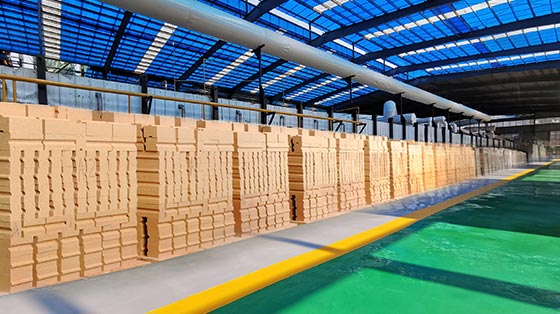Masonry process of fireway wall refractory brick:
(1) Construction preparation:
1) Before entering the site, the quantity and quality of refractory materials shall be strictly checked to meet the design requirements. After entering the site, the refractory materials shall be lifted to the construction area by crane in batches.
2) Pull out the vertical and horizontal center lines and horizontal elevation lines of the furnace body and mark them. Check again before construction to confirm that they are qualified.
3) The furnace bottom is leveled with 425 cement 1:2.5 (weight ratio) cement mortar. After the cement mortar solidifies, according to the center line of the furnace chamber and the center line of the transverse wall, pull out the masonry line of the firebrick masonry, and check that its size meets the design requirements, and then start the masonry.

(2) Furnace bottom masonry construction:
1) Lower furnace bottom construction: first, the brick pier is built longitudinally on the furnace bottom with clay standard brick, and then the upper surface is covered with castable precast block to make it an overhead furnace bottom.
2) Furnace bottom insulation layer construction: diatomite insulation refractory brick with masonry density of 0.7g/cm for 1-5 layers, and light high alumina brick with masonry density of 0.8g/cm for 6-8 layers.
3) Floor brick construction: two layers of irregular clay brick are used, each layer is 100 mm thick. Before masonry, take the elevation of the upper layer of the furnace bottom as the benchmark, pull out the layer line and mark it, and then start masonry.
For staggered joint masonry, the expansion joint shall be filled with dense and full refractory slurry.
(3) Surrounding wall masonry construction:
Set out and mark according to the center line, and set up the number pole at the joint with the transverse wall to control and adjust the elevation of each floor, so as to avoid excessive overall deviation. Check the masonry quality at any time during the masonry process to ensure that the flatness, verticality and reserved size of expansion joint of the wall meet the design and construction requirements.
The fire-resistant slurry in the expansion joint shall be filled tightly, and the construction area shall be cleaned when the wall is dry to 70%.
(4) Masonry construction of transverse wall:
During the construction of the cross wall, because the brick type of the end cross wall and the middle cross wall is different, each operator should be provided with a brick diagram. The first layer of brick should be pre built, and the groove of fire way wall should be reserved. In addition, the elevation of the 40th floor of the transverse wall should be 1-2mm lower than that of the 40th floor of the fire way wall.
During the masonry process, the double-sided stay wire should be used, and the verticality of the wall should be controlled by the control line of the side wall. The expansion joint between the transverse wall and the side wall shall be filled tightly.
(5) Masonry construction of fire passage and connecting fire passage:
Brick masonry of fire way wall:
1) When laying fireway wall bricks, because there are many types of bricks, the construction personnel are required to be familiar with the bricklaying drawing. The daily bricklaying shall not exceed 13 layers, and the vertical joints need not be filled with refractory slurry.
2) Before masonry, recheck the foundation elevation and center line of baking furnace and make timely adjustment, and use dry sand or refractory brick for leveling.
3) The elevation of the furnace wall should be strictly controlled according to the setting out size when building the fireway wall brick, and the ruler should be used to check the flatness of the wall at any time.
4) The reserved position and size of the expansion joint shall meet the design requirements, and the debris in the joint shall be cleaned before filling the refractory slurry.
5) When the firebrick at the lower part of the top sealing brick is built, the brick joints and vertical joints are not filled with refractory slurry. When the fireway is built on one side of the wall, the vertical joints are filled with refractory slurry.
6) The prefabricated block shall be manufactured according to the requirements before installation, and the allowable deviation of the size of the prefabricated block shall be within ± Within 5mm.
Brick masonry of connecting fire channel wall:
The connecting fire passage can be built independently or synchronously with the end transverse wall. When building the heat insulation layer, the material, quantity, number of layers and masonry position of the light heat insulation brick shall meet the design requirements.
(6) Furnace top installation:
The installation of the prefabricated block on the top of the furnace should start from one side. First, the upper connecting fire channel should be installed. Then, the prefabricated block of castable should be hoisted to the upper part of the fire channel wall.
Finally, the prefabricated block of castable on the transverse wall should be installed. When the upper part of the fire path is installed, 75 Mn zirconium containing thermal insulation fiberboard should be filled in the bottom of the castable.


 Wechat Us
Wechat Us